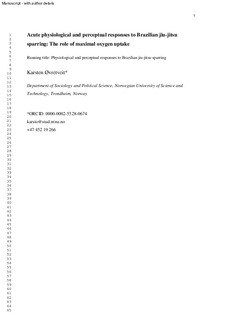| dc.contributor.author | Øvretveit, Karsten | |
| dc.date.accessioned | 2019-03-14T10:13:51Z | |
| dc.date.available | 2019-03-14T10:13:51Z | |
| dc.date.created | 2018-08-15T07:58:59Z | |
| dc.date.issued | 2018 | |
| dc.identifier.citation | International Journal of Performance Analysis in Sport. 2018, 18 (3), 481-494. | nb_NO |
| dc.identifier.issn | 1474-8185 | |
| dc.identifier.uri | http://hdl.handle.net/11250/2589977 | |
| dc.description.abstract | Sparring is a training form in combat sports designed to simulate fighting. This study sought to assess physiological and perceptual responses to Brazilian jiu-jitsu (BJJ) sparring and their relationship with maximal oxygen uptake (V̇O2max). Twelve male BJJ athletes (age: 30.6 ± 2.7 (SD) years; height: 182.5 ± 5.9 cm; body mass (mb): 81.2 ± 6.7 kg; body fat: 9.9 ± 3.2%) with 4.6 ± 2.2 years of BJJ experience and a training volume of 10.3 ± 4.4 h· week−1 participated in the study. Following a V̇O2max measurement, heart rate (HR), blood lactate concentration ([La‾]b), and rating of perceived exertion were obtained during sparring in a regular training session. Each participant sparred five consecutive 6-min rounds separated by 90-s breaks. Mean sparring HR was 164 ± 9 beats· min−1, equivalent to 85% ± 4% of the maximal HR (HRmax). The sparring was perceived as “hard”. Mass-independent V̇O2max correlated negatively with HR, relative HR (%HRmax), and [La‾]b (p <0.05). The inverse relationship between V̇O2max and physiological markers of exertion suggest that V̇O2max affects exercise tolerance in BJJ and could also point to a limited efficacy of sparring for developing aerobic endurance due to insufficient exercise intensity in trained athletes. | nb_NO |
| dc.language.iso | eng | nb_NO |
| dc.publisher | Taylor & Francis | nb_NO |
| dc.title | Acute physiological and perceptual responses to Brazilian jiu-jitsu sparring: the role of maximal oxygen uptake | nb_NO |
| dc.title.alternative | Acute physiological and perceptual responses to Brazilian jiu-jitsu sparring: the role of maximal oxygen uptake | nb_NO |
| dc.type | Journal article | nb_NO |
| dc.type | Peer reviewed | nb_NO |
| dc.description.version | acceptedVersion | nb_NO |
| dc.source.pagenumber | 481-494 | nb_NO |
| dc.source.volume | 18 | nb_NO |
| dc.source.journal | International Journal of Performance Analysis in Sport | nb_NO |
| dc.source.issue | 3 | nb_NO |
| dc.identifier.doi | 10.1080/24748668.2018.1493634 | |
| dc.identifier.cristin | 1602073 | |
| dc.description.localcode | Locked until 8.7.2019 due to copyright restrictions. This is an [Accepted Manuscript] of an article published by Taylor & Francis in [International Journal of Performance Analysis in Sport ] on [08 Jul 2018], available at https://doi.org/10.1080/24748668.2018.1493634 | nb_NO |
| cristin.unitcode | 194,67,25,0 | |
| cristin.unitname | Institutt for sosiologi og statsvitenskap | |
| cristin.ispublished | true | |
| cristin.fulltext | original | |
| cristin.qualitycode | 1 | |
